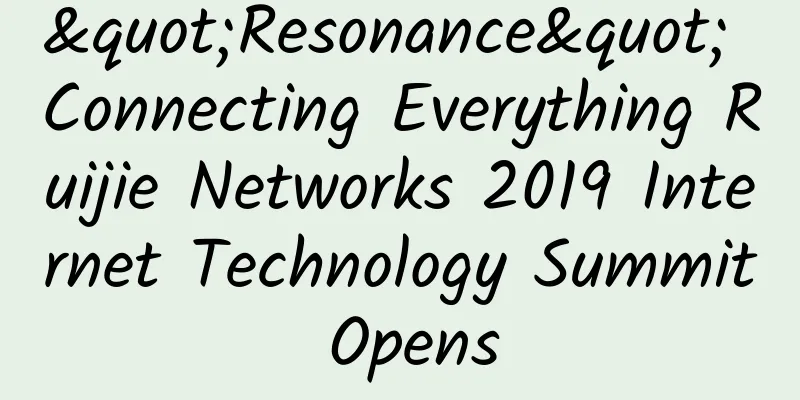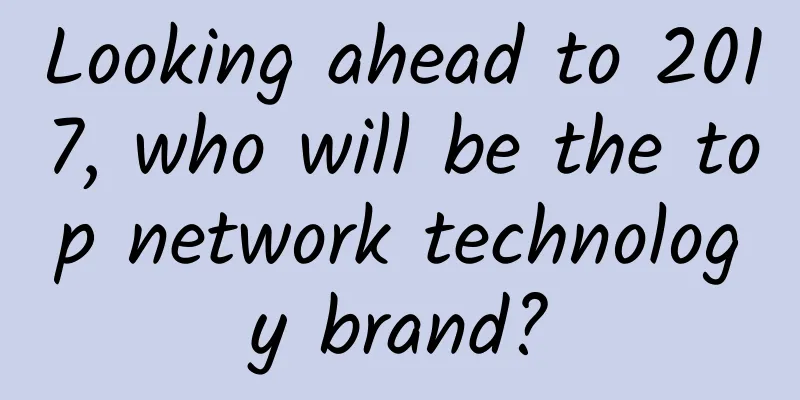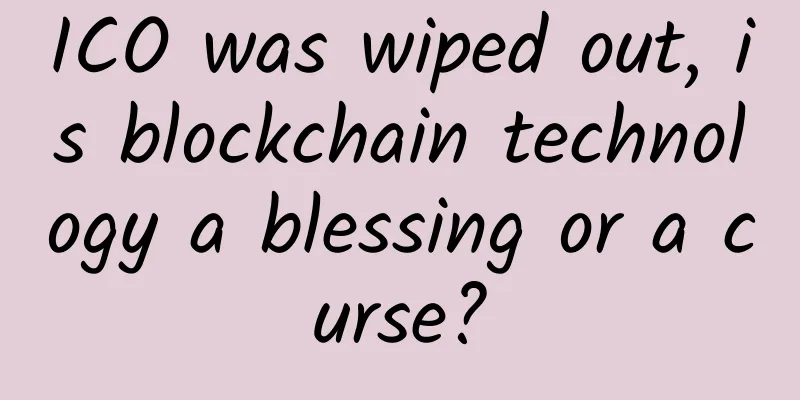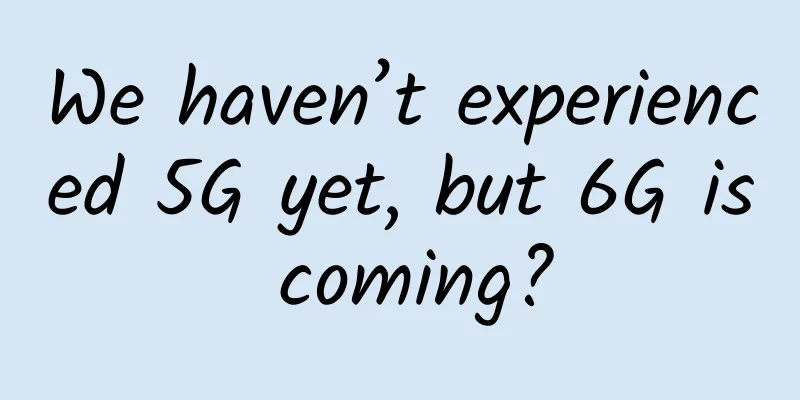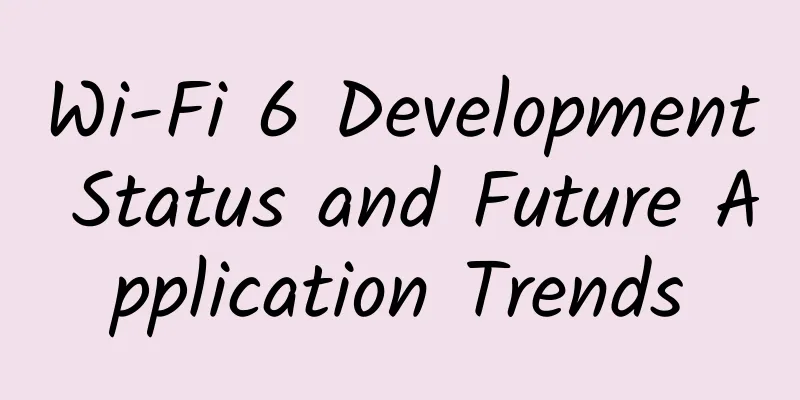How fast is 6G? You really should know in advance

|
When people are looking forward to the wonderful life of 5G, some people are already talking about the key technologies of 6G! This is really unexpected! At the "2018 Mobile World Congress North America", Ms. Jessica Rosenworcel, Commissioner of the Federal Communications Commission (FCC), said on behalf of the FCC that 6G will move towards the terahertz frequency era. As the network becomes more dense, blockchain-based dynamic spectrum sharing technology is becoming a new technological trend. Now there is no sign of 5G mobile phones, why are you talking to me about 6G technology issues...
5G is already so fast, will 6G be even faster? We know that the theoretical download speed of 5G is 10GB per second, which is 10 times the current 4G Internet speed. What about 6G? The theoretical download speed of 6G is 1TB per second (that is, 100 times that of 5G)! What does this mean? Take downloading a movie as an example. It only takes 1-2 seconds to download a high-definition blockbuster on a 5G network, while it only takes 10 milliseconds (0.01 seconds) on a 6G network! It is almost equivalent to watching online, and people will not feel any delay. However, it would be too superficial to only focus on network speed when talking about 6G, because in the 6G era, network speed is no longer important. Nowadays, the significance of the replacement of mobile communication technology is no longer limited to solving the problems of wireless communication and wireless Internet access between people, but to better solve the connection between things and between things and people, which is what we usually call the Internet of Things. The so-called Internet of Everything combines people, processes, data and things to make network connections more relevant and valuable. It transforms information into action, creates new functions for enterprises, individuals and countries, and brings richer experiences and unprecedented economic development opportunities. What is the Internet of Everything like? To give a simple example, you can use a mobile phone to control many things, such as giving instructions directly to your smart home, asking smart home robots to do housework, intelligently monitoring your family's every move, directly calling unmanned vehicles, and so on. Can 5G realize such high-tech life? Although our vision and expectation for 5G is the intelligent connection of all things, what it achieves is more about ultra-fast information transmission, and it is still some distance away from the true interconnection of all things. Taking network coverage as an example, applications such as Internet of Vehicles and telemedicine require a fully covered network with almost no blind spots. In this regard, 5G cannot be achieved overnight and needs to be supplemented and improved in the 6G era. Some experts have proposed that the 6G network will be a fully connected world integrating ground wireless and satellite communications. By integrating satellite communications into 6G mobile communications, global seamless coverage can be achieved, and network signals can reach any remote village, allowing patients in deep mountainous areas to receive telemedicine and children to receive distance education. In addition, with the linkage support of the global satellite positioning system, telecommunications satellite system, earth imaging satellite system and 6G ground network, the ground-to-air full coverage network can also help humans predict weather, respond quickly to natural disasters, etc. This is the future of 6G. 6G communication technology is no longer a simple breakthrough in network capacity and transmission rate. It is also aimed at narrowing the digital divide and realizing the "ultimate goal" of the Internet of Everything. This is the significance of 6G. What will 6G look like? Research on 6G has already begun. Miao Wei, Minister of Industry and Information Technology of my country, said: "At the end of last year or the beginning of this year, we have begun to study the development of 6G, which is the sixth generation of mobile communications." At present, institutions in Europe, the United States, Japan, South Korea and other countries have also started technical research on B5G or 6G. However, the definition of 6G has not yet appeared. Each party has its own vision, and there is no unified and universally recognized definition of 6G. At present, a more official answer is that 6G will explore and bring together related technologies that 5G has missed. At the 2018 Mobile World Congress North America, Jessica Rosenworcel, as the first commissioner of the Federal Communications Commission (FCC) to publicly discuss 6G wireless services, proposed three key technologies for 6G, which respectively involve 6G spectrum, how to achieve 6G wireless "ultra-large capacity", and how to innovate the use of 6G spectrum. This gives us a more specific outlook on 6G at the technical level. 1. 6G enters the terahertz frequency band, and the network becomes "densified" Rosenworcel said that 6G will use the terahertz (THz) frequency band, and the "densification" of the 6G network will reach an unprecedented level. By then, we will be surrounded by small base stations. The terahertz frequency band refers to 100GHz-10THz, which is a frequency band much higher than 5G. From 1G communication (0.9GHz) to the current 4G (above 1.8GHZ), the frequency of the radio electromagnetic waves we use is constantly increasing. Because the higher the frequency, the larger the bandwidth range allowed to be allocated, and the greater the amount of data that can be transmitted per unit time, which is what we usually call "faster network speed". However, another major reason for the development of higher frequency bands is that the resources in the low frequency bands are limited. Just like a road, no matter how wide it is, the number of vehicles it can accommodate is limited. When the road is not enough, vehicles will be blocked and unable to travel smoothly, and at this time it is necessary to consider developing another road. The same is true for spectrum resources. As the number of users and smart devices increases, the limited spectrum bandwidth needs to serve more terminals, which will cause the service quality of each terminal to seriously deteriorate. A feasible way to solve this problem is to develop new communication frequency bands and expand communication bandwidth. At present, the main 4G frequency bands of my country's three major operators are located in a part of the frequency band between 1.8GHz and 2.7GHz, while the mainstream frequency band of 5G defined by the International Telecommunication Standards Organization is 3GHz-6GHz, which belongs to the millimeter wave band. When it comes to 6G, it will enter the higher frequency terahertz band, and at this time it will also enter the submillimeter wave band. Gou Lijun, a researcher at the National Astronomical Observatory of the Chinese Academy of Sciences, said: "Terahertz is called submillimeter in astronomy. The sites of such observatories are generally very high and dry, such as Antarctica and the Acatama Desert in Chile." So why is it said that in the 6G era, the network will be "densified" and our surroundings will be filled with small base stations? This involves the coverage range of the base station, that is, the transmission distance of the base station signal. Generally speaking, there are many factors that affect the coverage of base stations, such as the frequency of the signal, the transmission power of the base station, the height of the base station, etc. In terms of the frequency of the signal, the higher the frequency, the shorter the wavelength, so the diffraction ability of the signal (also called diffraction, when an obstacle is encountered during the propagation of electromagnetic waves, and the size of the obstacle is close to the wavelength of the electromagnetic wave, the electromagnetic wave can diffract from the edge of the object. Diffraction can help cover the shadow area) is worse, and the loss is greater. And this loss will increase with the increase of transmission distance, and the range that the base station can cover will decrease accordingly. The frequency of 6G signals is already at the terahertz level, and this frequency has entered the spectrum of molecular rotation energy levels, which is easily absorbed by water molecules in the air, so the distance of propagation in space is not as far as 5G signals, and 6G requires more base stations to "relay". The frequency band used by 5G is higher than that of 4G. Without considering other factors, the coverage of 5G base stations is naturally smaller than that of 4G. When it comes to 6G, which has a higher frequency band, the coverage of base stations will be even smaller. Therefore, the density of 5G base stations is much higher than that of 4G, and in the 6G era, the density of base stations will be unprecedented. 2. Spatial multiplexing technology Rosenworcel said that 6G will use "spatial multiplexing technology", and 6G base stations will be able to access hundreds or even thousands of wireless connections at the same time, and their capacity will be 1,000 times that of 5G base stations. As mentioned earlier, 6G will use the terahertz frequency band. Although this high-frequency band has abundant frequency resources and large system capacity, mobile communication systems using high-frequency carriers face severe challenges in improving coverage and reducing interference. When the signal frequency exceeds 10GHz, diffraction is no longer the main propagation mode. For non-line-of-sight transmission links, reflection and scattering are the main signal propagation modes. At the same time, the higher the frequency, the greater the propagation loss, and the closer the coverage distance, the weaker the diffraction ability. These factors will greatly increase the difficulty of signal coverage. This is true not only for 6G, but also for 5G in the millimeter wave band. 5G solves this problem through two key technologies: Massive MIMO and beamforming. Our mobile phone signals are connected to the operator's base station, or more precisely, the antenna on the base station. Massive MIMO technology is quite simple to explain. It actually compensates for the loss on the high-frequency path by increasing the number of transmitting antennas and receiving antennas, that is, designing a multi-antenna array. The amount of data transmitted can be increased with the configuration of MIMO multiple antennas, and this is done by using spatial multiplexing technology. At the transmitter, the high-rate data stream is divided into multiple lower-rate sub-data streams, and different sub-data streams are transmitted on the same frequency band on different transmitting antennas. Since the spatial sub-channels between the antenna arrays at the transmitter and receiver are sufficiently different, the receiver can distinguish these parallel sub-data streams without paying additional frequency or time resources. The advantage of this technology is that it can increase channel capacity and improve spectrum utilization without occupying additional bandwidth or consuming additional transmission power. However, MIMO's multi-antenna array will focus most of the transmission energy in a very narrow area. In other words, the more antennas there are, the narrower the beam width. The advantage of this is that there will be less interference between different beams and between different users, because different beams have their own focus areas, which are very small and do not overlap with each other. But it also brings another problem: the narrow beam emitted by the base station is not 360-degree omnidirectional. How to ensure that the beam can cover users in any direction around the base station? This is when beamforming technology comes into play. Simply put, beamforming technology manages and controls beams through complex algorithms, making them like "spotlights". These "spotlights" can find where mobile phones are gathered, and then provide more focused signal coverage. 5G uses MIMO technology to improve spectrum utilization. 6G is located in a higher frequency band, and the further development of MIMO in the future is likely to become a key technical support for 6G. 3. Dynamic spectrum sharing + blockchain Rosenworcel mentioned that the current spectrum allocation (auction) method in the United States will not be able to meet the demand for "efficient use of spectrum resources" in the 6G era, and 6G will adopt the "spectrum sharing" method. She also pointed out that a more intelligent and distributed dynamic spectrum sharing access technology can be used, that is, "dynamic spectrum sharing based on blockchain." The so-called spectrum auction refers to the authorization of a user to plan a certain frequency band, conduct an open auction, and transfer the right to use the frequency band to the highest bidder through public bidding. At present, the regions and countries where spectrum auctions are widely used are mainly concentrated in Europe and the United States. Unlike most countries, my country adopts the method of allocation rather than auction to manage spectrum. Therefore, my country's government regulatory departments are in a very core position in the development of the mobile communications industry. The reason why the spectrum auction allocation method is not able to meet the demand of "efficient use of spectrum resources" in the 6G era is that it has problems such as spectrum idleness and insufficient utilization caused by the exclusive use of frequency bands by authorized users. For a scarce strategic resource such as radio spectrum, this method is obviously not suitable for welcoming the arrival of the era of intelligent interconnection of all things, and it is even very likely to hinder the promotion of innovation in the entire society. In order to rationally allocate spectrum resources and make them fully and efficiently used, the US FCC promoted dynamic spectrum sharing in 2015 and launched CBRS (common wireless broadband service) at 3.5GHz. It dynamically manages different types of wireless traffic through a centralized spectrum access database system to improve spectrum utilization efficiency. Simply put, if a user does not use it, other users can access it, which can not only effectively reduce resource waste, but also reduce congestion problems (this is a bit like sharing bicycles). CBRS introduces a three-tier spectrum access architecture (SAS). SAS is divided into three tiers: the first tier of users are license holders of the frequency band, such as military radars. This tier of users has the highest priority and will be protected at the highest level from interference from users at other tiers; the second tier is users who have paid the license fee and are protected from interference from users at the third tier; the third tier is available to anyone, has the lowest priority, and is not protected from any interference. SAS is responsible for coordinating spectrum access between existing and new users, protecting higher-level users from the impact of lower-level users, and optimizing the efficient use of available spectrum for all users within the CBRS band. This achieves the effect of dynamically sharing the spectrum band and using it on demand, and the utilization rate of the spectrum will undoubtedly be greatly improved. CBRS is highly creative, efficient and forward-looking, and has extraordinary significance for the future development of 6G. However, for 6G, dynamic spectrum sharing will obviously have to develop on the original basis. CBRS supports spectrum sharing access through a centralized database. If the system can explore the use of blockchain as a low-cost alternative to dynamic spectrum sharing technology based on blockchain technology that uses a distributed database, it can not only reduce the management cost of the dynamic spectrum access system and improve spectrum efficiency, but also further increase the access level and the number of access users. Rosenworcel believes that the application of blockchain in 6G, using a "decentralized" distributed ledger to record various wireless access information, will further stimulate new technological innovations and even "change the way 6G uses wireless spectrum in the future." In fact, there is no unified conclusion on the concept of 6G. For example, researchers in Bristol, UK, said that they are developing microwave technology based on diamond gallium nitride to explore 6G technology. Some people also see 6G as having the ability to self-aggregate networks of different types. The technical trend forecast for 6G also includes ultra-dense cellular networks, reconfigurable hardware, millimeter wave user access, enhanced optical wireless interfaces, network VLC, artificial intelligence management and orchestration of cellular network integration, etc. No matter how rich the concept of 6G is, just like 5G to 4G, the future 6G must be the continuous evolution of 5G. What 5G has, we need to rely on 6G to improve. And what 5G does not have, we need to rely on 6G to expand. Is it too early to study 6G now? Regarding 6G, not only some people think it is too early to research it now, but some professionals also hold such a view. Mike Short, who worked at Telefonica for 17 years and is now the chief scientific adviser to the UK government's international trade agency, said: "I think 6G is not worth everyone's efforts before 2022. What we need to do now is to discover the real needs of users for 5G and make 5G commercially available before talking about 6G." Is it really too early to study 6G now? It’s not too early at all, and we need to act quickly. Why? In fact, we can understand it just from the development of 5G. The research on 5G millimeter wave technology did not start when 4G showed its limitations. Its theoretical basis was completed as early as 18 years ago (2000), but the industry achieved the maturity of millimeter wave technology 10-15 years later. Until now, the large-scale commercial deployment of millimeter wave 5G is still a problem. This is the case with 5G's millimeter wave, not to mention the terahertz frequency band used by 6G. In addition, the early deployment of 6G networks is also to prepare for a rainy day and seize the initiative. As the scale of 5G connections continues to expand, network pressure will increase, and 6G will definitely come. In the research of 5G, my country has already entered the "first echelon". Although 6G has not officially started, some countries have already started research and development. In the future, whoever occupies the commanding heights of the 6G network first will be able to take the lead in opening a new era of the Internet of Everything. The strategic significance of 6G is self-evident. Conclusion It took 30 years for mobile communication technology to evolve from analog technology to the second generation of mobile communication technology (2G) marked by GSM, 15 years for the evolution from 2G to 3G, and 5 years for the launch from 3G to 4G. The speed of technology upgrade is getting faster and faster, and the time for each generation of communication technology to become the commercial mainstream is getting shorter and shorter. Now that 6G is on the way, perhaps its popularity will come even faster! |
>>: Inventory: Three basic elements and five characteristics of the Industrial Internet
Recommend
SpectraIP: €3.5/month KVM-2GB/50GB/5TB/Netherlands data center
SpectraIP is a Dutch hosting company that provide...
How to speed up banking business innovation through comprehensive real-time monitoring?
In recent years, with the gradual deepening of th...
5G, where is the road ahead? Computer experts look ahead to the 5G era
[[348682]] Data released by the Ministry of Indus...
Essential for operation and maintenance: 20 common service ports and their corresponding service information
In the operation and maintenance process, it is c...
Quickly understand the characteristics and differences of HTTP1.0 1.1 2.0 3.0
HTTP1.0 HTTP version 1.0 is a stateless, connecti...
What is holding women back from becoming programmers?
Ding Ling, a modern Chinese feminist writer, publ...
GigsGigsCloud:$16/month KVM-1GB/30GB/1TB/1.6T High Defense/Los Angeles CN2 GIA+AS9929
GigsGigsCloud is a long-established foreign hosti...
Ruijie's all-scenario cloud desktop leads the new trend of Internet medical development
At present, affected by the epidemic, Internet me...
How is an excellent testing infrastructure created? eBay's Ru Bingsheng talks about the history of testing evolution
[51CTO.com original article] The Global Software ...
Virtualization Journey
So, how can enterprises fully realize the benefit...
New infrastructure is just starting, 5G is just beginning, and the key year for smartphones is 2021
"New infrastructure" is one of the core...
Unlimited mobile data packages are criticized: "Unlimited" is very big, and "Speed limit" is hard to find
Since the three major operators launched unlimite...
From R15 to R17, understand 5G's technological innovation in one article
In early June 2022, the 96th plenary session of t...
How should we respond to the 5G era? Talking about the prospects and career planning from the perspective of the Internet industry
The 5G war is in full swing, so what are the coun...
iWebFusion: $168/month - Dual E5-2697v3, 256G memory, 1TB NVMe hard drive, 25TB/1Gbps, 5 data centers including Los Angeles
I would like to share some information about high...

